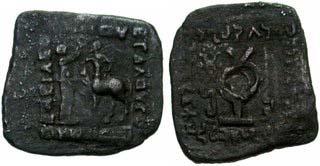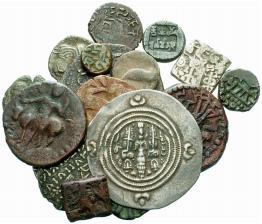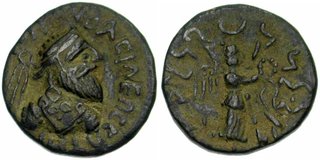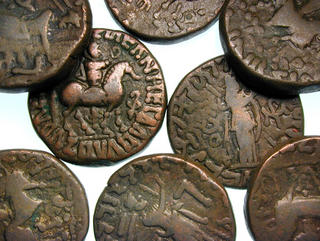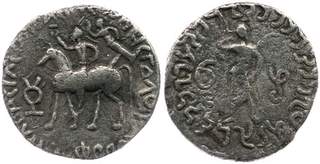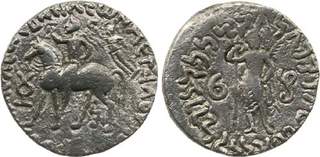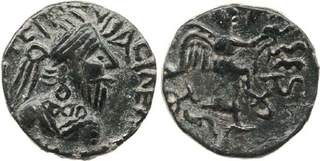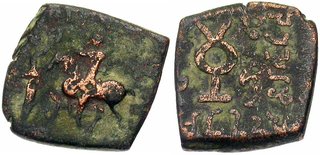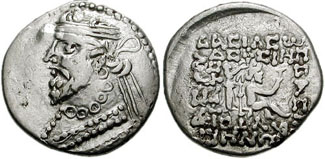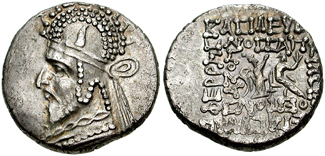|
Today pepper is our single most
commonly used spice, routinely
offered in fine restaurants and
fast food joints alike and
universally available in stores
and supermarkets. It is
therefore hard to imagine just
how highly prized pepper was in
ancient and medieval times and
how it spurred a complex trade
that saw peppercorns travel
distances so enormous that their
origins remained obscure even to
their purveyors. Along the way,
fortunes were made, lives were
lost, and the spice became
enriched with its connotations
of mystery and exoticism
|
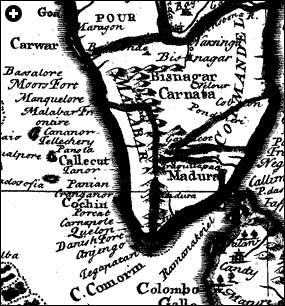
HERMAN MOLL (1736) |
|
Since at least the first
millennium BC, pepper was
regarded as an ultimate luxury,
inessential to survival yet
highly desired for ritual,
medicinal and culinary purposes.
The origins of this desire
stretch back to ancient Egypt,
with the great pharaoh Ramses II
being the first known consumer,
albeit posthumously: peppercorns
were found in the nostrils of
his mummified corpse. In ancient
Greece, pepper was used
medicinally and the Chinese have
used it in their cooking since
at least the fourth century. The
Romans' conquest of Egypt gave
them regular access to pepper,
and it became a symbol of
luxurious cookery. It was traded
ounce for ounce with precious
metals: When Rome was besieged
in the fifth century, the city
allegedly paid its ransom in
peppercorns, and the spice
remained an accepted form of
"currency" throughout the Middle
Ages.
The period from roughly the
first century BC to the first
century of our era witnessed a
surge in the pepper trade as
navigators began to understand
the pattern of the Indian Ocean
monsoon, and the surge resulted
in more detailed knowledge about
the lands where the pepper
grows.
In 70 AD, the Periplus Maris
Erythraei, an anonymous
merchant's guide to the Red Sea,
recorded information on the
spice trade and the now lost
Indian port of Muziris. Large
ships are sent there, the author
reports, "on account of the
great quantity and bulk of
pepper" that is only grown in
that region. Even though
archeologists still debate its
exact location, it is clear from
the Periplus and other
references that Muziris was
located near the modern city of
Kodungallor (formerly known as
Cranganore, its colonial name)
on India's Malabar Coast, where
black pepper is native.
Pepper was once a gift fit for
kings; above, a French
manuscript illustration from the
early 15th century shows both
harvesting and royal
presentation.
|
|
The Malabar Coast comprises a
narrow sliver of land on the
southwestern tip of peninsular
India, hemmed in by the Arabian
Sea to the west and the mountain
range of the Western Ghats in
the east. This region, now
largely contained in the
northern part of the Indian
state of Kerala, is located in
the humid equatorial tropics:
the annual monsoon rains nourish
the fertile soil, feed the
extensive network of backwater
canals, and support the region's
rich biodiversity. In addition
to being the source of pepper,
Malabar's position at the center
of the Indian Ocean made it a
natural location for commerce
and transshipping. For these
reasons, foreign merchants
hailing from the different
corners of the Indian Ocean
trading world established
settlements in Malabar's ports
and brought with them not only
their commercial expertise but
also their cultures and creeds. |
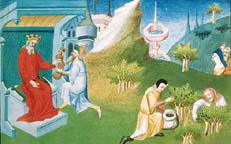
BIBLIOTHEQUE NATIONALE /
BRIDGEMAN ART LIBRARY |
|
As
the original suppliers of pepper
to the Mediterranean world, the
Persians had sailed along the
coast to Malabar since the
earliest days of maritime
navigation. Jews are believed to
have arrived and established
synagogues as early as the sixth
century BC. The Christians of
modern Kerala trace their
ancestry to Thomas the Apostle,
who they believe came to Muziris
in the year 52; they are known
to this day as St. Thomas
Christians.
|
|
Peppercorns are the dried fruit
of the wild climbing vine Piper
nigrum, which is native to the
rich soil and humid climate of
the Malabar Coast. It is
unrelated to the American chili
fruit, often called "chili
pepper."
In the same century, ships from
China reached South India and
created the long-lasting
connection between the Chinese
empire and Malabar: This was as
evident to medieval visitors,
who spoke of Malabari
communities known as "sons of
the Chinese," as it is to modern
tourists who marvel at the
peculiar shore-based fishing
contraptions known as "Chinese
nets." Traders from other parts
of India, especially Gujarat to
the north and Coromandel on the
east coast, also established
permanent trading communities on
the Malabar Coast, often
specializing in particular
goods. But what would prove to
be the most profound foreign
influence on Malabar did not
arrive for another five
centuries, when a new religion
spread across the lands around
the Indian Ocean, galvanized
their commerce and created
immense wealth through the trade
in pepper. |
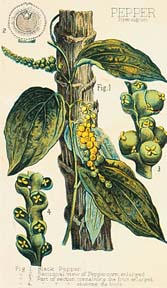
CYNTHIA HART DESIGNER /
CORBIS |
|
Despite their reputation as a
desert people, Arabs had long
been involved in maritime trade.
Yet it was only with the
unifying, expansionist and
proselytizing energy of early
Islam that Arabs were able to
develop their traditional
dominance over the caravan and
Red Sea trade into a network of
Muslim settlements that rapidly
spread along the Indian Ocean
littoral. Under the early
caliphates, this Islamic network
matured to encompass most of the
Indian Ocean world from East
Africa to the southern coast of
China. It carried with it not
only the beliefs of Islam but
also the Arabic language,
shari'a courts able to enforce
common legal standards and
shared commercial practices that
favored the interaction of these
settlements. Merchants residing
in foreign ports were able to
learn the local language,
establish and maintain business
contacts, and act as
cross-cultural brokers. Muslim
trade settlements developed into
particularly effective
organizations because of the
political unity initially
created by a burgeoning Islam,
the great emphasis on literacy
within its culture and the
practice of pilgrimage, which
kept its heartlands in
communication with even the most
far-flung settlements. Even
though the bulk of Indian Ocean
commerce was carried on Indian
and Chinese ships, and despite
the continued significance of
Jewish merchants, Arab Muslims
increasingly dominated trade in
its most profitable commodity:
pepper. |
|
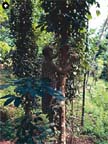
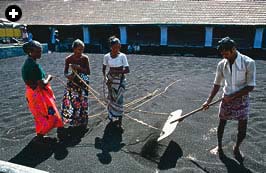 |
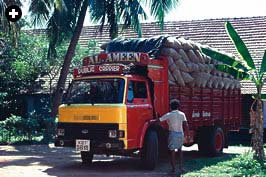 |
|
The
Piper nigrum vine grows readily
and widely, and it reaches
several meters in height. Like
Indian Ocean navigation, the
rhythm of growing and harvesting
is set by the monsoon. Black,
white and green pepper are all
fruits of the same plant,
respectively dried, decorticated
and brined or freeze-dried.
Air-drying black pepper requires
frequent turning, and is still
most often accomplished simply
by spreading the pepper out in
the sun.
The momentous commercial
expansion during the early
centuries of Islam was driven by
the demand for spices in Europe
and in the grand capitals of the
new Islamic states. Within the
lucrative spice trade, pepper
was the most important commodity
in bulk and value, and so the
Malabar Coast remained of
central importance to the Indian
Ocean trading world. In his
description of Malabar, the
14-century Moroccan traveler Ibn
Battuta recorded his
astonishment at seeing pepper,
elsewhere valued by the grain,
"being poured out for measuring
by the bushel, like millet in
our country." It is therefore
not surprising that Malabar was
the first region of India to
attract Muslim traders in
significant numbers. The Malabar
Coast was originally inhabited
by the Dravidian people, who
were distinct in their languages
and culture from the Indo-Aryans
of northern India. Organized
religions came to Kerala in the
form of Jainism, Buddhism and
later Hinduism, and expressed
themselves in the construction
of temples—their profusion in
the region has led Kerala to be
called "the land of temples." A
revived Hinduism developed into
the region's predominant
religion from about the ninth
century onward, when Kerala's
royal houses patronized Brahmins
from North India.
The origins of Islam on the
Malabar Coast began, according
to legend, with the last king of
the South Indian Chera dynasty,
which had ruled Malabar since
the beginning of its recorded
history. Cheraman Perumal, the
tale goes, converted to Islam
after having dreamt of a
splitting moon and then meeting
Arab pilgrims who reported that
the Qur'an mentions just such a
miracle (54:1–2). The king
resolved to join the pilgrims in
their journey to Makkah, but not
before dividing his kingdom
among his princes, a
fragmentation that would
characterize the region for many
centuries.
Having fallen ill on the return
journey and unable to make it to
his homeland, the king entrusted
the same pilgrims with the
mission of founding mosques and
propagating his new faith in
Kerala. Many of the oldest
mosques in the region are said
to have been founded by these
pilgrims, who were dispatched
all along the coast to serve as
qadis to its fledgling Muslim
communities.
The legend of Cheraman Perumal
is similar to conversion myths
in other parts of Asia and
appears to be a confusion of two
distinct traditions, one
relating the end of unified
Chera rule over Kerala and the
other the conversion of a king.
Its appeal and longevity,
however, are testament to the
exceptional circumstances that
surrounded the introduction of
Islam to Kerala and to the
unique history of the
communities it created.
Furthermore, many aspects of
this tale can be linked to
historical truths. To begin to
understand this blend of fact
and fiction, therefore, we must
look at the intriguing history
of the Muslims of Malabar and
their unique blend of Islamic
traditions and South Indian
customs.
Islam was introduced to the
Malabar Coast peacefully by Arab
traders in search of pepper and
by Sufis who traveled within the
commercial networks. To this
day, most Muslims of Malabar
adhere to the Shafi'i school of
Islamic law, which was dominant
among Muslim merchants across
the Indian Ocean world. They are
also more closely linked to Arab
culture than to the Persian
influence that was brought to
the rest of India by invaders
from the north. Muslim merchants
settling in Malabar ports
married (often multiple) local
women. Their offspring were the
first generation of Indian-born
Muslims, and their upbringing in
both Arabic and the local
language, Malayalam (not related
to the Malay language of
Southeast Asia), was an
excellent preparation for future
work as brokers. In this manner,
the ports of the Malabar Coast
became ever more closely woven
into the network of Islamic
trade spanning the Indian Ocean,
and the wealth of the expatriate
merchants and their associates
increased.
As the legend of Cheraman
Perumal already suggests,
another significant factor in
the introduction of Islam to
Malabar was conversion. Aside
from rare exceptions, these did
not, however, occur in the
ruling class but in the lower
strata of society. Hinduism in
this part of South India had
developed a particularly rigid
system of caste division, with
social intercourse between
castes severely restricted to
avoid ritual pollution.
Conversion to Islam was
therefore a chance for low-caste
Hindus to break free of such
limitations, and also opened new
opportunities for economic
interaction with the prosperous
Arab merchants. This group of
new Muslims native to Malabar
developed into a distinct
community known as Mappilas (or
Moplahs). These new converts
preserved many of their
traditional practices and
integrated them into their new
Islamic identity. Some Mappilas,
for instance, continued the
practice of matrilineality in
which descent is understood to
be of the mother's bloodline.
The particular cultural heritage
of this community is preserved
in the Mappila songs, an
indigenous form of devotional
folklore in the Malayalam
language.
From about the thirteenth
century onwards, Kozhikode
(anglicized "Calicut") emerged
as the coast's dominant port. It
was the center of a princely
state ruled by hereditary
sovereigns known as Zamorins.
These were particularly renowned
for their tolerance on the one
hand—they for instance granted
merchant communities independent
jurisdiction over their
members—and their scrupulousness
in upholding property rights on
the other, and they built a
reputation for honesty that
helped to turn Kozhikode into
the region's principal port. Ibn
Battuta explicitly states that,
because of this reputation,
Kozhikode had become "a
flourishing and much frequented
city" and one of the most
important ports in the world.
Foremost among its cosmopolitan
assemblage of foreign merchants
were the Muslim traders. These
became over time not only the
Zamorins' main source of tax
revenue but also allies in their
ambitions to subjugate other
princely states, often through
the provision of ships and
sailors for naval warfare.
Historians such as K. M.
Panikkar are of the opinion that
the Zamorins were on course
towards subjecting and unifying
Malabar under their rule, but
that "this very process gave
rise to jealousies and feuds"
that were easily exploited by
the Portuguese after their
arrival on the coast. |
|
Pepper
Pliny, writing his Natural
History in the first century,
was puzzled by the demand for
pepper that dictated its high
price: "Its fruit or berry are
neither acceptable to the tongue
nor delectable to the eye: and
yet for the biting pungency it
has, we are pleased with it and
must have it set forth from as
far as India." By Pliny's time,
pepper had long been part of
European commerce and
imagination about the East.
Alexander the Great is believed
to have brought pepper back from
his expeditions. He introduced
its Sanskrit name, pippali, from
which the Greek piperi was
derived and passed on to the
Semitic languages (Hebrew pilpel
and Arabic filfil) as well as to
the European languages through
the Latin piper.
Today pepper is still considered
the "king of spices" and added
to almost any kind of recipe.
Pepper was already the most
frequently used oriental spice
in medieval Europe, and
descriptions of lavish banquets
often refer to the luxuriously
large quantities of pepper used
in their preparation. Aside from
its culinary function of spicing
up foods, pepper was also valued
for its supposed medicinal
properties, in particular as an
antidote to poisoning and as a
cure for impotency. Its high
price relative to volume also
made it a useful currency: The
Roman emperors stored great
amounts of it in their treasury.
As information about the East
increased in late antiquity, so
did the knowledge about the
plants and regions that produced
this most sought-after
commodity.
Peppercorns are the dried fruit
of the wild climbing vine Piper
nigrum, which is native to
Kerala. The vine grows readily
and widely in the rich soil and
humid climate of southern India
and reaches several meters in
height by climbing trees or
trellises. Medieval travellers
to Malabar were amazed at how
widely the pepper vine was
cultivated, with even the
smallest gardens including at
least a few plants. Black, white
and green pepper are all fruits
of Piper nigrum. The peppercorns
are usually picked unripe. If
they are then brined or
freeze-dried, they remain green
and keep a fresh, vegetal flavor
and a mild tang. If they are
sun-dried, the flesh of the
fruit blackens and shrivels to a
thin coating and the spice
develops a richer flavor as well
as more heat. To produce white
pepper, with heat but little
flavor, the peppercorns are
soaked in water and the flesh is
then rubbed off the seeds.
Rarely, peppercorns may be
allowed to ripen to red before
being picked. The name "pepper"
has been profitably applied to
many other plants—Malaguetta
pepper, long pepper and all the
New World capsicums (chili
peppers)—but true pepper is only
Piper nigrum, and the
connoisseur's choice is Malabar
pepper, preferably the
deep-flavored grade the trade
calls Tellicherry Extra Bold.
|
|
Pepper's high profits helped
propel European colonialism, and
this engraving depicts the port
of Bombay (now Mumbai) in the
mid-18th century, when much of
Malabar's pepper exports passed
through that entrepôt into the
holds of ships of the British
East India Company.
When Vasco da Gama's fleet
reached Kozhikode in May 1498,
he came "in search of Christians
and spices." He was initially
content to imagine having found
the former: He believed the
Hindus to be an aberrant
Christian sect and even offered
prayers at a Hindu temple,
albeit somewhat puzzled by the
|
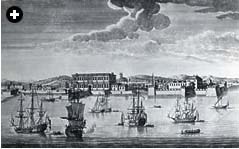 |
|
depiction of "Our Lady" with
multiple arms. The desire for a
monopoly of the pepper trade,
however, was more difficult to
quench: The Portuguese soon
realized the prominence of Arab
traders in the town and their
control over the pepper trade.
Laden with a profound antagonism
toward Muslims born of the
Reconquista, the Portuguese were
not content to trade alongside
other merchant communities. When
the second fleet reached Malabar
in 1500, its commander, Cabral,
demanded that the Zamorin expel
all Muslim merchants from the
port. This stood in marked
contrast to the long tradition
of free trade that had been the
source of Kozhikode's
prosperity, and the ruler
responded (in the words of the
Portuguese chronicler) that he
could not comply "for it was
unthinkable that he expel 4000
households of them, who lived in
Calicut as natives, not
foreigners, and who had
contributed great profits to his
Kingdom."
Already
during the second European
expedition to India,
confrontation became inevitable:
While the Europeans were no
match for the economic strength
of Muslim merchants, their
ship-mounted artillery and
military expertise proved to be
the force majeure. The
Portuguese seized and destroyed
Muslim merchant vessels,
regularly bombarded Kozhikode
and other ports, and exploited
rivalries among the coast's
princely states to establish
fortified factories.
They used their advantage in
maritime violence to enforce a
royal monopoly on the spice
trade and to sell permits to
other ships that wished to trade
on the coast, and the Portuguese
"pepper empire" was born.
The initial returns on the
expeditions were staggering, and
Lisbon soon replaced Venice as
the main importer of pepper to
Europe. But the Portuguese
violence in India also
galvanized resistance. The
Zamorins together with the
Muslim merchants repeatedly
assembled fleets, but despite
some small victories they could
not break the Portuguese
domination of the sea. The ruler
of Kochi (formerly Cochin) to
the south of Kozhikode, who had
long been a resentful subject of
the Zamorins, allowed the
Portuguese to build a factory as
their base on the Malabar Coast.
A long period of warfare at sea
and on land ensued, and repeated
attempts were made to incite
other Islamic states to assist
the Mappilas' struggle. Egyptian
merchants were able to rouse the
Mamluk sultan to send a fleet,
but after inconclusive
engagements his ships retreated.
As Portugal's power in the
Indian Ocean expanded over the
following decades, Malabar
developed into a major test case
of their imperial ambitions.
Foreign Muslims were able to
move to safer ports and conduct
their business from there. That
they did so successfully is
evident by the great quantities
of pepper that again became
available in the markets of
Alexandria and Venice by the
mid-16th century, often
undercutting the prices at which
the Portuguese could sell it at
Lisbon. The local Mappila
Muslims, on the other hand, had
no choice but to stay and to
resist or evade the Portuguese
monopoly system.
Excluded from the opportunities
of regular commerce, the Mappila
communities became increasingly
militarized. While some resorted
to smuggling and indiscriminate
piracy, others turned to forms
of guerrilla warfare to harass
Portuguese shipping. The
Portuguese, claiming ownership
of all of the sea, soon
described all Mappilas as
pirates and treated them as
such. The Mappilas used small
ports in northern Malabar as
bases, and by the mid-16th
century a Muslim called Kunjali
Marakkar was granted the
hereditary admiralty of the
Zamorin's fleet. He and his
successors inflicted several
defeats on Portuguese armadas,
but when, toward the end of the
century, Kunjali iv asserted his
independence of the Zamorin, the
ruler allied with the Portuguese
and together they eventually
defeated the Mappila
strongholds.
Around the same time, the Muslim
historian Zain al-Din, whose
family had come to Malabar from
Yemen in the 15th century, wrote
his famous Tuhfat al-Mujahidin
(Gift to the Holy Warriors)
describing the cruelty of the
"Franks" in an attempt to
persuade the Muslim states of
northern India to assist the
Mappilas in their struggle. The
historian Stephen Dale argues
that the Mappila Muslims
developed a particular idiom of
holy warfare that, instead of
reflecting the conquest of new
territories by Muslim powers,
expressed a religious struggle
born of individual desperation.
This found expression in popular
festivals (the nerccas), at
which folk ballads celebrating
the Mappila victims of the
anti-colonial struggle are
recited.
The profits of the pepper trade
eventually motivated other
European powers to join the
fray, and in time the Portuguese
were eclipsed first by the Dutch
and later by the British.
Throughout the centuries,
economic and political
circumstances continued to
conspire against the Mappilas
and led to recurrent riots and
attacks. However, the Mappilas
also preserved their link to the
sea, mostly as fishermen in
Kerala's rich waters, and
strengthened their involvement
in riverine trade and
agriculture. Today, Muslims
constitute about a quarter of
Kerala's population and remain
concentrated in the north of the
state on the historic Malabar
Coast; in contrast to other
regions of India, Kerala
experiences very little of the
problems of sectarianism. In
recent years, many Mappilas have
found work in the Middle East,
particularly in Saudi Arabia and
the United Arab Emirates, and so
continue the long-standing ties
that bind the regions and
societies. While historically
pepper may have been as much of
a blight as a blessing for the
Malabar Coast, there can be no
doubt that, because of it, the
region served as a nexus where
the dynamics of world history
were played out —a point for
reflection on the next turn of
the pepper mill. |
|
High roofs and slatted
clerestories helped traditional
Mappila mosques, such as this
one photographed in 1936 in
Ponnani, maintain comfort for
worshipers in the hot coastal
climate. |
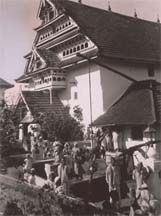
BASEL MISSION PICTURE ARCHIVE |
The Nakhuda Mithqal Mosque (or
Mithqalpalli) in Kozhikode is
named for a 14th-century Arab
merchant and dates to 1578, when
it was rebuilt following
destruction of the original by
the Portuguese.
|
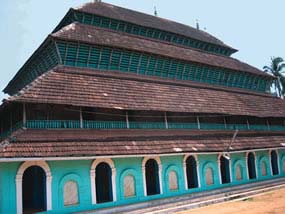
SEBASTIAN
PRANGE |
|
Malabar Mosques
Kerala is known as "the land of
temples" for its multitude of
Hindu places of worship, but its
little-known mosques are no less
fascinating in their style and
history. The Malabar Coast is
believed to have been the site
of the first mosques on the
Indian subcontinent, but because
of the destruction brought by
Portuguese bombardments and
subsequent invasions, there are
no mosques that date before the
12th century. The earliest
extant mosques are located in
the old Muslim quarters of
Kozhikode and Kochi and bear
inscriptions noting donations
from Arab merchants and
shipmasters. These traditional
mosques (palli in the local
language, Malayalam) are
remarkably different from the
styles of Islamic architecture
found in Arabia or elsewhere in
India: For example, they do not
feature domes or minarets.
Rather, they show clear
similarities to the design of
vernacular houses and local
Hindu temples. This is partly a
result of the region's
particular conditions (for
instance, the steeply sloped
roofs to cope with the large
amounts of rainfall) and the
available materials and skills.
Yet the similarities were not
only dictated by necessity but
may also reflect the desire to
find a place in the prevailing
ritual landscape: New converts
to Islam would have already had
clear ideas about what
constitutes a sacred space from
the region's existing temples.
The archetypal Malabar mosque is
a covered structure on a
rectangular ground plan, often
with verandas running around the
prayer hall. Especially
characteristic is the intriguing
tiered roof structure, sometimes
covered with copper sheets, with
the upper stories often used as
a madrasa and as offices for the
imam. Mehrdad Shokoohy, a
historian and architect, has
recently studied the mosques of
Malabar and describes in detail
the amalgamation of local
designs with specific features
from the Arabian lands and
Southeast Asia. In this view,
Malabar's mosques are a fitting
manifestation of the remarkable
extent of the medieval Muslim
trading world and its spirit of
cross-cultural stimulation and
exchange
|
|
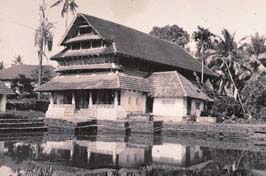 |
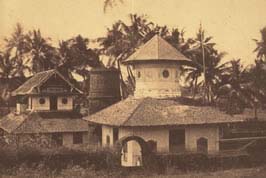 |
|
Left:
A mosque in
an
unrecorded
location,
circa 1939.
Right:
A mosque
near
Chirakkal,
circa 1855.
|
|
|
|
By
Sebastian R. Prange
Acknowledgement: This article
appeared on pages 10-17 of the
January/February 2008 print
edition of Saudi Aramco World.
Refer the book Kodungallur
Cradle of Christianity in India,
by Prof. George Menachery (1987)
at www.indianchristianity.com.on
BOOKS page. Also article "Roads
to India" by Maggy G. Menachery,
in the St. Tomas Christian
Encyclopaedia of india, 1973,
Ed. Prof. George Menachery.
|
|
Rome-India Sea Route rivaled
Silk Road |
|
Spices, gems and other exotic
cargo excavated from an ancient
port on Egypt's Red Sea show
that the sea trade 2,000 years
ago between the Roman Empire and
India was more extensive than
previously thought and even
rivaled the legendary Silk Road,
archaeologists say.
"We talk today about globalism
as if it were the latest thing,
but trade was going on in
antiquity at a scale and scope
that is truly impressive," said
the co-director of the dig,
Willeke Wendrich of the
University of California at Los
Angeles.
Wendrich and Steven Sidebotham
of the University of Delaware
report their findings in the
July issue of the journal
Sahara. Historians have long
known that Egypt and India
traded by land and sea during
the Roman era, in part because
of texts detailing the
commercial exchange of luxury
goods, including fabrics, spices
and wine.
Now, archaeologists who have
spent the last nine years
excavating the town of Berenike
say they have recovered
artifacts that are the best
physical evidence yet of the
extent of sea trade between the
Roman Empire and India.
They say the evidence indicates
that trade between the Roman
Empire and India was as
extensive as that of the Silk
Road, the trade route that
stretched from Venice to Japan.
Silk, spices, perfume, glass and
other goods moved along the Silk
Road between about 100 B.C. and
the 15th century.
"The Silk Road gets a lot of
attention as a trade route, but
we've found a wealth of evidence
indicating that sea trade
between Egypt and India was also
important for transporting
exotic cargo, and it may have
even served as a link with the
Far East," Sidebotham said.
Among their finds at the site
near Egypt's border with Sudan
included more than 16 pounds (7
kilograms0 of black peppercorns,
the largest stash of the prized
Indian spice ever recovered from
a Roman archaeological site.
Bernike lies at what was the
southeastern extreme of the
Roman Empire and probably
functioned as a transfer port
for goods shipped through the
Red Sea. Trade activity at the
port peaked twice, in the first
century and again around 500,
before it ceased altogether,
possibly after a plague.
Ships would sail between
Berenike and India during the
summer, when monsoon winds were
strongest, Wendrich said. From
Berenike, camel caravans
probably carried the goods 240
miles (386 kilometers) west to
the Nile, where they were
shipped by boat to the
Mediterranean port of
Alexandria, she said. From
there, they could have moved by
ship through the rest of the
Roman world.
www.mikalina.com/images/silk_road.jpg
(Los Angeles AP Also cf.
Kodungallur by Prof. George
Menachery, 1987 & Roads to
India, Maggy Menachery, St.
Thomas Christian Encyclopaedia
of India, ed G Menachery, 1973.
www.indianchristianity.com BOOKS
page.
Refer the book Kodungallur
Cradle of Christianity in India,
by Prof. George Menachery (1987)
at www.indianchristianity.com.on
BOOKS page. Also article "Roads
to India" by Maggy G. Menachery,
in the St. Tomas Christian
Encyclopaedia of india, 1973,
Ed. Prof. George Menachery.
|
THE SEA-ROUTE TO INDIA & THE RED
SEA TRADE
|
|
As
Vasco da Gama forced his way up
the East African coast, he
sought a pilot who could guide
his ships to India. But da Gama
was not the most patient or
forgiving of Portuguese
explorers and his quick, violent
temper made the task more
difficult; a minor incident in
Mozambique prompted da Gama to
bombard the city. It would only
be at Kilwa that a suitable
pilot could be found. Ibn Majid,
the most distinguished Asian
navigator of his time, was
retained by the Portuguese
captain. Under Majid's expert
guidance, the Portuguese ships
quickly made their way to
western India. "On Friday, 18th
May," wrote da Gama in his
Journal, "after having seen no
land for twenty-three days, we
sighted lofty mountains, and
having all this time sailed
before the wind we could not
have made less than 600 leagues.
The land, when first sighted,
was at a distance of eight
leagues, and our lead reached
bottom at forty-five fathoms."
After finally landing in Calicut,
da Gama's journal records that
the Portuguese sailor was
greeted with the words "May the
devil take thee! What brought
you hither?" When asked what he
sought so far away from home, da
Gama replied that he came in
search of Christians and of
spices.
This was not, however, the
Orient that the European captain
thought he would encounter.
Instead of finding a single
opulent realm, da Gama found
innumerable states with a vast
and complex commercial network.
Perhaps more surprising was that
in the Indian Ocean ports that
it had taken the Portuguese
nearly a century to find by sea,
da Gama found merchants who for
centuries had been trading
European metals and gold bullion
for Indian and imported spices
through the Venetians. In
addition to European goods, da
Gama also saw items from North
Africa and Malaya, and gold and
ivory from East Africa. The
distances involved astounded da
Gama.
As an example of how vast these
trading routes were, we have
only to look at the trade in the
Indian Ocean, where the
prevailing monsoons determined
the course of trade. Between
November and April, the monsoons
blow from the north-east and
from May to October, the
monsoons blow from the
south-west. In southern Malay,
where the north-east winds of
the Indian Ocean meet the
south-west winds of the China
seas, Malacca emerged as the
"richest place in the world". In
Malacca, the Portuguese found
the business of the city was
conducted by all manner of
merchants and seamen. Merchants
gathered from the furthest
reaches of the known world,
Tunis and China, bringing with
them Chinese silks, Indian
textiles, East Indian spices,
and European goods that arrived
via Cairo and Aden. The
merchants were Christians, many
more were Hindu, but all managed
to co-exist peacefully in this
environment, and the Portuguese
soon discovered that most seamen
and traders in the Indian Ocean
and beyond were Muslims, a
forbidding development for da
Gama who when asked what had
brought him across such a great
distance replied "Christians and
spices".
In India, da Gama encountered
the same difficulties he had
when his ships were in Indian
Ocean ports. Without suitable
goods to trade, Portuguese
attempts to enter the lucrative
commerce of the region were
unsuccessful. Furthermore,
Portuguese arrogance and
disregard for local custom soon
eroded the initial goodwill
displayed by the Hindu raja. In
certain instances, the
Portuguese improperly worshiped
at Hindu shrines, and da Gama
kidnapped some of the local
inhabitants to serve as
interpreters for subsequent
voyages, all of which served to
antagonise the local population.
Perhaps more importantly, local
merchants, who learned of
Portuguese behaviour in Africa
and who were seeing it displayed
in their own country, had no
desire to see their livelihood
destroyed and refused to trade
with the Europeans.
Approximately half the fleet
with which da Gama departed
Lisbon two years before survived
to make the return voyage home.
As a feat of nautical endurance
and skill, da Gama's voyage was
a superb testament to the raw
maritime skills of the
Portuguese - nearly 300 days
were spent at sea. But it must
be remembered that the sea route
to India was found only with the
expert guidance of Ibn Majid who
knew how to properly use the
wind system of the Indian Ocean.
Da Gama was amply rewarded for
his services despite the fact
that he did not return with the
desired alliances, nor was he
able to secure any commercial
concessions. Still, while in
Calicut, the Portuguese captain
took into his service a Tunisian
Muslim and a Spanish Jew from
whom he learned some of the
intricacies of the Asian economy
and how it might be manipulated
to serve Portuguese interests.
Armed with this important
information, King Manuel I was
determined to establish a
monopoly on the spice trade of
the Indian Ocean by "cruel war
with fire and sword".
MARITIME TRADE
After Vasco da Gama reached
India in 1498, the Portuguese
Crown moved to secure the safety
of the sea route and sent da
Gama to accomplish this task.
During his voyage, da Gama
encountered stiff Muslim
opposition to Portuguese
attempts to enter the trade of
the Indian Ocean, and
consequently the Portuguese
captain believed he would have
to force his way into the
market. Fortunately for the
Portuguese, the empires of
Egypt, Persia and Vijayanagar
did not arm their vessels, if
they had ships at all. Malay
vessels, primarily known as
lanchara, were small, single
square-rigged vessels steered by
two oars mounted in the stern.
By and large, most Muslim
merchants had large ocean-faring
ships, complemented by smaller
coastal ships, but even these
were not outfitted to carry
artillery and no iron was used
in their hull construction.
Consequently, the merchants'
vessels were much more
susceptible to damage than were
the Portuguese ships and this
meant that the Portuguese were
able to gain control of the
Indian Ocean with relative ease.
Prior to the emergence of the
Portuguese, control of maritime
trade in the Indian Ocean was
established peacefully. Over the
centuries, a mutually beneficial
relationship developed between
Muslim traders and Hindu
merchants and the Portuguese
could offer little in the way of
goods or services to supplant
the established network.
Moreover, the Portuguese
believed that Venetian merchants
were monopolising trade of
European goods and preventing
them from gaining access to the
lucrative markets in the Indian
Ocean. The Portuguese quickly
surmised that they could only
change the status quo by
resorting to brute force.
Refer the book Kodungallur
Cradle of Christianity in India,
by Prof. George Menachery (1987)
at www.indianchristianity.com.on
BOOKS page. Also article "Roads
to India" by Maggy G. Menachery,
in the St. Tomas Christian
Encyclopaedia of india, 1973,
Ed. Prof. George Menachery. Also
the 15 books and 22 extracts
from books in The Indian Church
History Classics, Vol. I: The
Nazranies, 1998 ed.Prof. George
Menachery.
|
-
The Red Sea Trade Route
-
250 BC - 250 AD
|
|
During the period between 250 BC
and 250 AD, a maritime sea route
existed between Alexandra in
Northern Africa and China. As
trade took place along this
route, a number of kingdoms rose
to power, flush with finances
from trade. These kingdoms all
came into being around the same
time, and all waned around the
same time.
Trade on the Red Sea was in the
hands of merchants based out of
Alexandria. Nabataeans moved
trade from Southern Arabia to
their port of Leuce Come by
boat, and then overland to
Alexandria. "Arab" merchants
also brought Indian and Asian
goods to the ports on the
Egyptian side of the Red Sea.
For a time it may have been
Indian ships that brought the
good to Southern Arabia, as
Diodorus tells us of the
'prosperous islands near
Eudaemon Arabia which were
visited by sailors from every
port of the world, and
especially from Potana, the city
which Alexander the Great
founded on the Indus river.' (Diodorus.
3.47.9.) |
 |
|
Another description of this
situation is found in a text
known as 'The Periplus of the
Erythraean Sea' by an unknown
author. Many have assumed he was
a Greek living in Alexandria,
but he may have just as well
have been an Arab merchant with
a Greek name living in
Alexandria. In it we read that 'Eudaemon
Arabia (Aden) was once a
fully-fledged city, when vessels
from India did not go to Egypt
and those of Egypt did not dare
sail to places further on, but
came only this far.' (L. Casson,
ed. The Periplus Maris Erythraei
(Princeton 1989) 26., lines
26-32) Any attempts by
Alexandrian ships to sail beyond
Aden were strongly discouraged;
if they did sail, it was by
laboriously hugging the coasts
and in the words of Periplus,
'sailing round the bays'. |
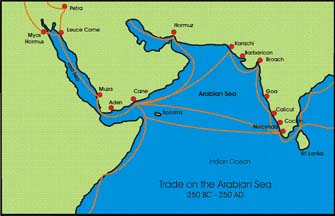 |
|
This was the situation until
Roman financiers entered the
Alexandrian money market towards
the middle of the 2nd century
BC. The ensuing rise of demand
for oriental and southern goods
in the Mediterranean markets
whetted the appetite of Arab
merchants based in Alexandria to
increase their share in the
north-south trade. They realized
that they needed to sail
directly across the Indian Ocean
to the rich Indian market and
bring good back to Egypt,
without the involvement of
Indian merchants. Ptolemy VIII,
friend of Rome, as was his wife
after him, demonstrated personal
interest and involvement in the
project which indicated the
great hopes all parties in
Alexandria attached to the
success of the venture. While it
is not known who made the first
direct voyage to India, very
soon a new important office was
created for the first time in
the Egyptian administration. It
was know as the 'commander of
the Red and Indian Seas,' and
came into being under Ptolemy
XII, nicknamed Auletes (80-51
BC). (Sammelbuch, 8036, Coptos
(variously dated 110/109 BC or
74/3 BC; and no. 2264 (78 BC);
Inscriptions Philae, 52 (62 BC)
The creation of such an office
implies that the perhaps at this
time there was a marked increase
in the regular commercial
transactions with India.
It is also perhaps not entirely
irrelevant that in 55 BC, the
Senate decided to send Gabinius
at the head of a Roman army to
restore Auletes (Ptolemy XII) to
his throne and to remain in
Alexandria for the protection of
the king against possible future
revolts. (Caesar, BC. 3. 110).
We can easily detect behind this
drastic step, considerable Roman
assets at risk in the case of
sudden undesirable internal
changes in Alexandria.
This should warn us against
accepting at face value Strabo's
often quoted remark that it was
only under 'the diligent Roman
administration that Egypt's
commerce with India and
Troglodyte was increased to so
great an extent. In earlier
times, not so many as twenty
vessels would have dared to
traverse the Red Sea far enough
to get a peep outside the
straits (Bab-el-Mandab), but at
the present time, even large
fleets are dispatched as far as
India and the extremities of
Aethiopia, from which the most
valuable cargoes are brought to
Egypt and thence sent forth
again to other regions.' (Strabo,
17.1.13.) This is clearly an
overstatement, intended as a
compliment to the new Roman
administration, considering that
Aelius Gallus, the prefect of
Egypt, was Strabo's personal
friend at whose house he stayed
as a guest for five years (25-20
BC). Strabo's statement stands
in sharp contrast to the earlier
data of the above mentioned
inscriptions and to the more
matter-of-fact statement of the
later author of the Periplus (c.
40 AD), who rightly perceived
that the great change in the
modes of navigation and the vast
expansion of trade were the
direct result of the discovery
of the Monsoon winds, at least
half a century before Augustus
conquered Egypt. Strabo himself
witnessed the flourishing state
of Alexandria only five years
after the Roman conquest, and
very shrewdly observed the
active trade that went through
its several harbors. He says,
'Among the happy advantages of
the city, the greatest is the
fact that this is the only place
in all Egypt which is by nature
well situated with reference to
both things, both to commerce by
sea, on account of the good
harbors, and to commerce by
land, because the river easily
conveys and brings together
everything into a place so
situated, the greatest emporium
in the inhabited world.'
Soon after the annexation of Egypt, Emperor Augustus (Rome 63 BC - Nole 14
AD) in 26 BC commissioned his
prefect in Egypt, Aelius Gallus,
to invade southern Arabia by
land. (Strabo, 16.4.23-4.) This
land onslaught caused
considerable damage to the
Sabaeans as far as Marib, and
allowed the Himyarites, close
friends of the Nabataeans to
soon take control of most of
Southern Arabia. Some writers
have thought that around AD 1
Augustus launched another
devastating attack - this time
by sea - which resulted, in the
words of Periplus,'in sacking
Eudaemon Arabia' which declined
into, 'a mere village after
having been a fully fledged city
(polis)'. (Periplus, 26; Pliny,
H.N. 6.32, 160 & 12.30,55; Also
cf. H. MacAdam, 'Strabo, Pliny
and Ptolemy of Alexandria', in:
Arabie Pre-Islamique (Strasbourg
1989) 289-320.) Now that
Eudaemon Arabia (Aden) was out
of action, merchants from
Alexandria experienced
unrivalled dominance of the sea
route to India.
|
|
Pattanam dated to 1st millennium
BCE
The radiocarbon analysis at the
Institute of Physics,
Bhubaneswar, has put the
antiquity of Pattanam (Kerala,
India) to the first millennium
BCE. What is more, the studies
suggest that the canoe found in
a water-logged trench at
Pattanam canoe could be the
earliest known canoe in India.
The five samples that were
analysed include charcoal
samples and parts of the wooden
canoe and bollards recovered
from trenches. The mean calendar
dates of these five samples
place the antiquity of ancient
maritime activity of Pattanam at
about 500 BCE. The artefacts
have revealed that the site had
links with the Mediterranean,
Red Sea, Arabian Sea and South
China Sea rims since the Early
Historic Period of South India. |
 |
|
"Pattanam
is the first habitation site of
the Iron Age ever unearthed in
Kerala. Since previous enquiries
were confined to megalithic
burials, no firm dates were
available for the Iron Age,
except a few like Mangadu (circa
1000 BCE) and unnoni," said P.J.
Cherian, project director of
Pattanam excavations. The
radiocarbon dates from Pattanam
is therefore expected to help in
understanding the Iron Age
chronology of Kerala.
"The indigenous people seems to
have settled on the site during
the Iron Age when this area was
covered by beach sand. The
occupation has been sparse and
the sand deposit has mostly
black-and-red ware and other
typical `megalithic' pottery,"
added P.J. Cherian.
The Archaeological Survey of
India has granted licence to
Project Director P.J. Cherian
for a second consecutive season
and the work is scheduled to
begin in February 2008. Besides
the excavation activities at
Pattanam, the licences are for
archaeological exploration
within 50 km around Kodungallur
and underwater explorations in
the water-bodies within 20 km
radius. |
| |
|
|














